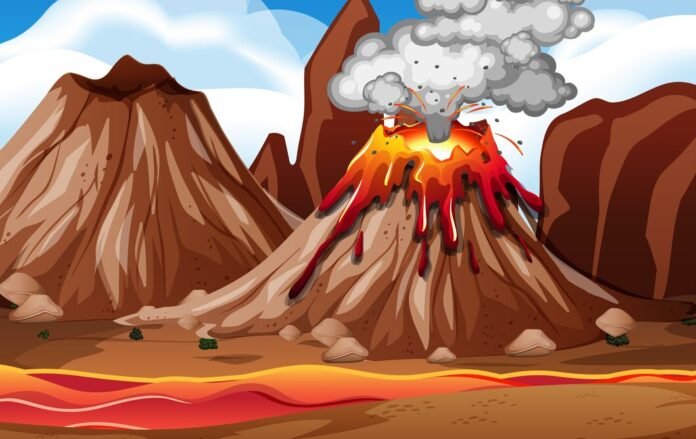Introduction
A volcano is a landform with an opening through which the molten rocks and metal present in the mantle layer of the earth leak out onto the earth’s crust. Volcanoes can be mountain-like or on a plane surface. Based on the volcanic stage, a volcano can be categorized as active, inactive, or extinct type. However, based on the nature of eruption and structure, there are five major types of volcanoes: shield volcanoes, composite volcanoes, caldera,flood-basalt provinces, and mid-ocean ridge volcanoes.
Types of Volcanoes Based on Frequency of Eruption
Active Volcanoes
The volcanoes which are continuously erupting or have erupted in the recent past are called active volcanoes. Mt. Etna in Italy and Kīlauea in Hawaii are two examples of active volcanoes in the world.
Dormant or Inactive volcanoes
The volcanoes which have erupted a long time back in human history but are expected to erupt again in the future are called dormant or inactive volcanoes. Mount Fuji in Japan and Mount Kilimanjaro in Africa are popular examples of dormant volcanoes.
Extinct Volcanoes
The volcanoes which have never erupted in human history but show evidence of eruption earlier in geological time scale are called extinct volcanoes. Mount Oregon in the US is an example of an extinct volcano.
Types of Volcanoes Based on Nature of Eruption and Structure
Shield Volcanoes
Shield volcanoes are the largest volcanoes on earth. They are very high and spread across a wide area. The lava that erupted out of these volcanoes is mainly basalt. It is very fluid and hence does not form steep slopes. These volcanoes are not very explosive however, if water enters their vent then they may become explosive. The lava coming out of the volcano throws up a cone forming a cinder cone. Hawaiian volcanoes are famous examples of shield volcanoes.
Cinder Cones
Cinder cones are small steep volcanoes having a small crater at the top. These are formed by extrusive igneous rocks called cinder or scoria. These volcanoes are made up of loose grainy cinders and almost no lava.
Composite Volcanoes
Composite volcanoes are moderately steep volcanoes that give out comparatively cool and more viscous lava. Along with lava, other pyroclastic materials are thrown out of these volcanoes that get deposited in layers. This gives these volcanoes a composite structure. Sometimes these volcanoes are characterised by the presence of small craters near the vent. Composite volcanoes are explosive.
Caldera
Caldera volcanoes are characterized by a large depression caused by the collapse of the volcano. Calderas are the most explosive volcanoes in the world. They explode with such intensity that they collapse rather than build up any taller structure. Their explosiveness suggests that the magma chamber is very large and lies in close vicinity.
Flood Basalt Provinces
Flood basalt provinces are formed when the lava comes out of the cracks in the Earth’s crust and flows long distances. This deposition may become very thick around 50 m. The Deccan traps that cover most of Maharashtra, are among the largest basalt provinces in the world.
Mid-Oceanic Ridges
These volcanoes appear in the ocean bed. They are part of mountain ranges that spread across 70,000 kilometres forming the longest chain of mountains on the earth’s surface. The central region of the mid-oceanic region is the region of intense volcanic activity.
How are Volcanoes Formed?
Volcanoes are formed when the pressure within the earth forces the magma out of an opening in the earth’s crust. The mantle of the earth is divided into two layers. The upper layer of the mantle is a weak zone consisting of molten rocks and metal called magma. This magma comes out to the surface of the earth where it is called lava and gets deposited in layers usually forming volcanoes.
Recommended Articles:
Types of Wind – Planetary, Periodic, Monsoon and Variable
Uniform and Non-uniform motion
Unit Conversion
Unit of Capacitance
Unit of Conductivity
Magma is the molten rock material present in the mantle layer inside the earth. Once this magma reaches the crust and starts coming out during volcanic eruptions, it is referred to as lava. The Pacific ring of fire is a horseshoe-shaped region at the rim of the Pacific ocean. This region is characterized by intense volcanic activities and earthquakes. Some famous calderas are Crater lake in Oregon, Ngorongoro in Tanzania, La Garita in Colorado, Silverthrone in British Columbia, etc. Pyroclastic materials are materials that come out of a volcano during an eruption. These include lava, fragments of igneous rocks, ashes, and gas. A fast-moving flow of pyroclastic material is called a pyroclastic flow. Yes, there is one active volcano in India located on Andaman's Barren Island. It recently erupted in the year 2017. There are seven volcanoes in India. They are Barren Island in Andaman, Deccan traps in Deccan India, Narcondam Island in Andaman, Baratang Island in Andaman, Dhosi Hill in Haryana, Dhinodhar hill in Gujarat, and Tosham hill in Haryana. Types of Volcanoes FAQs
What is the difference between magma and lava?
What is the Pacific Ring of Fire?
What are some of the famous Calderas?
What is pyroclastic material?
Is there any active volcano in India?
How many volcanoes are present in India?
